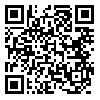BibTeX | RIS | EndNote | Medlars | ProCite | Reference Manager | RefWorks
Send citation to:
URL: http://jhsw.tums.ac.ir/article-1-5527-en.html

 , Amir Hosein Kokabi2
, Amir Hosein Kokabi2 
 , Kamal Azam3
, Kamal Azam3 
 , Somayeh Farhang Dehghan4
, Somayeh Farhang Dehghan4 
 , Ali Karimi5
, Ali Karimi5 
 , Farideh Golbabaei *
, Farideh Golbabaei * 
 6
6
2- Professor, Department of Materials Science and Engineering, Sharif University of Technology, Tehran, Iran
3- Associate Professor, School of Public Health, Tehran University of Medical Sciences, Tehran, Iran
4- Assistant Professor, Department of Occupational Health, School of Public Health, Shahid Beheshti University of Medical Sciences, Tehran, Iran
5- Assistant Professor, Department of Occupational Health Engineering, School of Public Health, Tehran University of Medical Sciences, Tehran, Iran
6- Professor, Department of Occupational Health Engineering, School of Public Health, Tehran, Iran ,
Introduction: Nowadays, Shielded Metal Arc Welding (SMAW) is the most widely used arc welding. During the welding operation, typically, various harmful agents such as fumes, gases, heat, sound and ultraviolet radiation are produced of which fume is the most important component from the viewpoint of occupational health. The present study aims to compare the number and the mass concentration emitted in SMAW to determine the most appropriate index of exposure to fumes in the welding processes.
Material and Method: In this study, the portable laser aerosol spectrometer and dust monitor of GRIMM, model 1.106, was used to measure the number and mass concentration of fumes emitted from SMAW on 304 stainless steel with a thickness of 0.4 mm. Air sampling was performed at a distance of 41 cm representing the welder’s breathing zone. The measurements of number concentration (NC) and mass concentration (MC) were taken under the condition of 25 volt voltage and direct current of the electrode polarity.
Result: The total NC and MC of welding fumes in welder’s breathing zone was 1140451 particles per liter and 1631.11 micrograms per cubic meter, respectively. The highest number concentration was found to correspond to the particles with 0.35 to 0.5 micrometer-sized distribution (NC1; 938976 particles per liter) and the lowest was related to the particles with 5 to 6.5 micrometer-sized distribution (NC7; 288 particles per liter) and the particles larger than 6.5 micrometer (NC8; 463 particles per liter). Moreover, the highest mass concentration was related to the particles with 0.35 to 0.5 micrometer-sized distribution (MC1; 450 micrograms per cubic meter) and the particles larger than 6.5 micrometer (MC8; 355 micrograms per cubic meter).
Conclusion: The findings indicated that there is no agreement between number and mass concentration as two particles assessment index, and as the particles’ size become smaller, the mismatch of them is becoming more apparent. Since the smaller particles penetrate into the lower respiratory tract and have higher potential for adverse health effects, it is necessary to measure and assess particles in various size distributions and especially the smaller fraction of particles. Therefore, it is thought that considering the mass concentration alone and not paying attention to number concentration in the assessment of exposure to particles in the industrial workplaces and specifically in welding stations will not be reflected valid assessment of adverse health effects of welding fumes as a systemic poison on body organs.
Received: 2016/12/7 | Accepted: 2016/12/7 | Published: 2016/12/7
| Rights and permissions | |
 |
This work is licensed under a Creative Commons Attribution-NonCommercial 4.0 International License. |



